Value Chain and Its Ethical Issues: Analysis of Uber’s Business Processes
VerifiedAdded on 2022/09/08
|15
|3557
|17
AI Summary
Contribute Materials
Your contribution can guide someone’s learning journey. Share your
documents today.
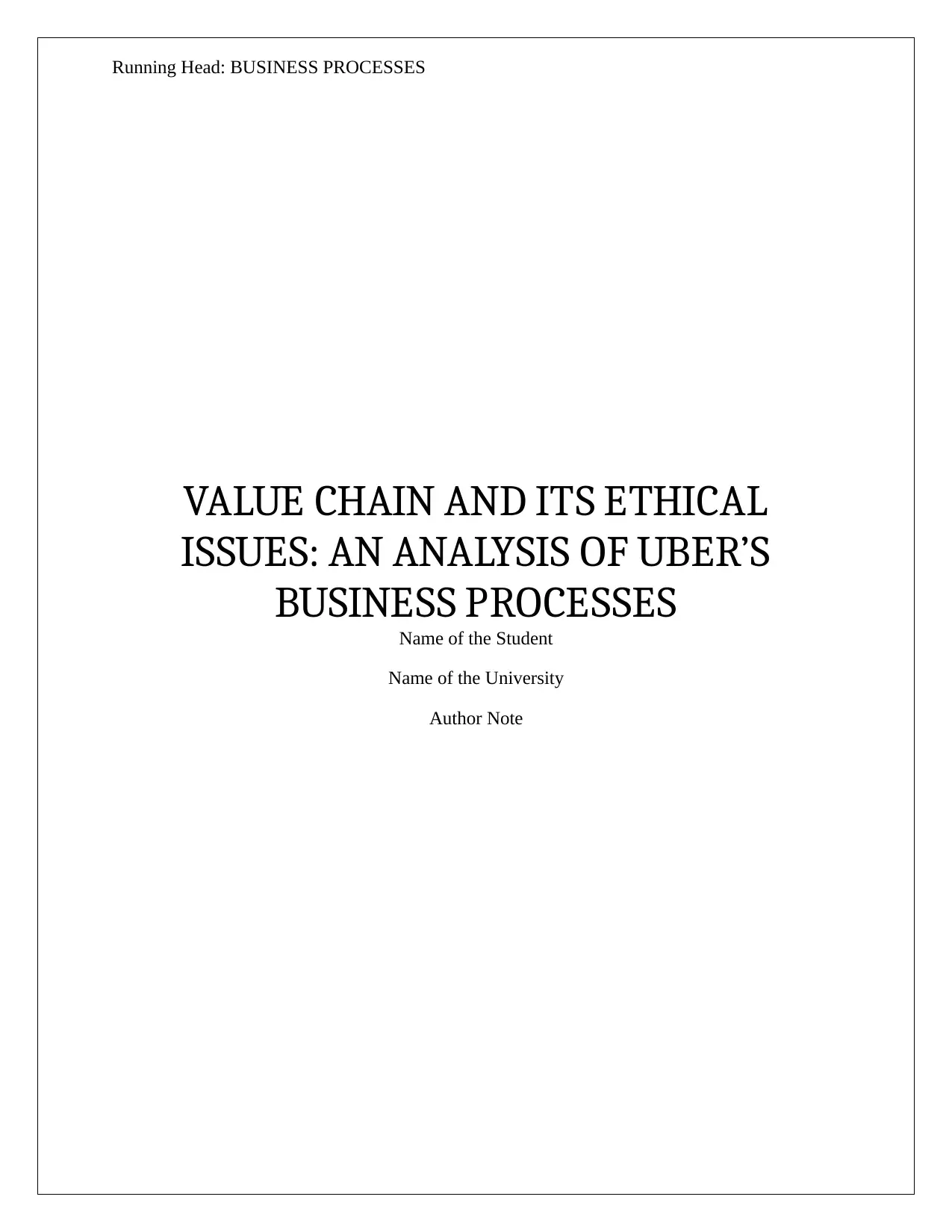
Running Head: BUSINESS PROCESSES
VALUE CHAIN AND ITS ETHICAL
ISSUES: AN ANALYSIS OF UBER’S
BUSINESS PROCESSES
Name of the Student
Name of the University
Author Note
VALUE CHAIN AND ITS ETHICAL
ISSUES: AN ANALYSIS OF UBER’S
BUSINESS PROCESSES
Name of the Student
Name of the University
Author Note
Secure Best Marks with AI Grader
Need help grading? Try our AI Grader for instant feedback on your assignments.
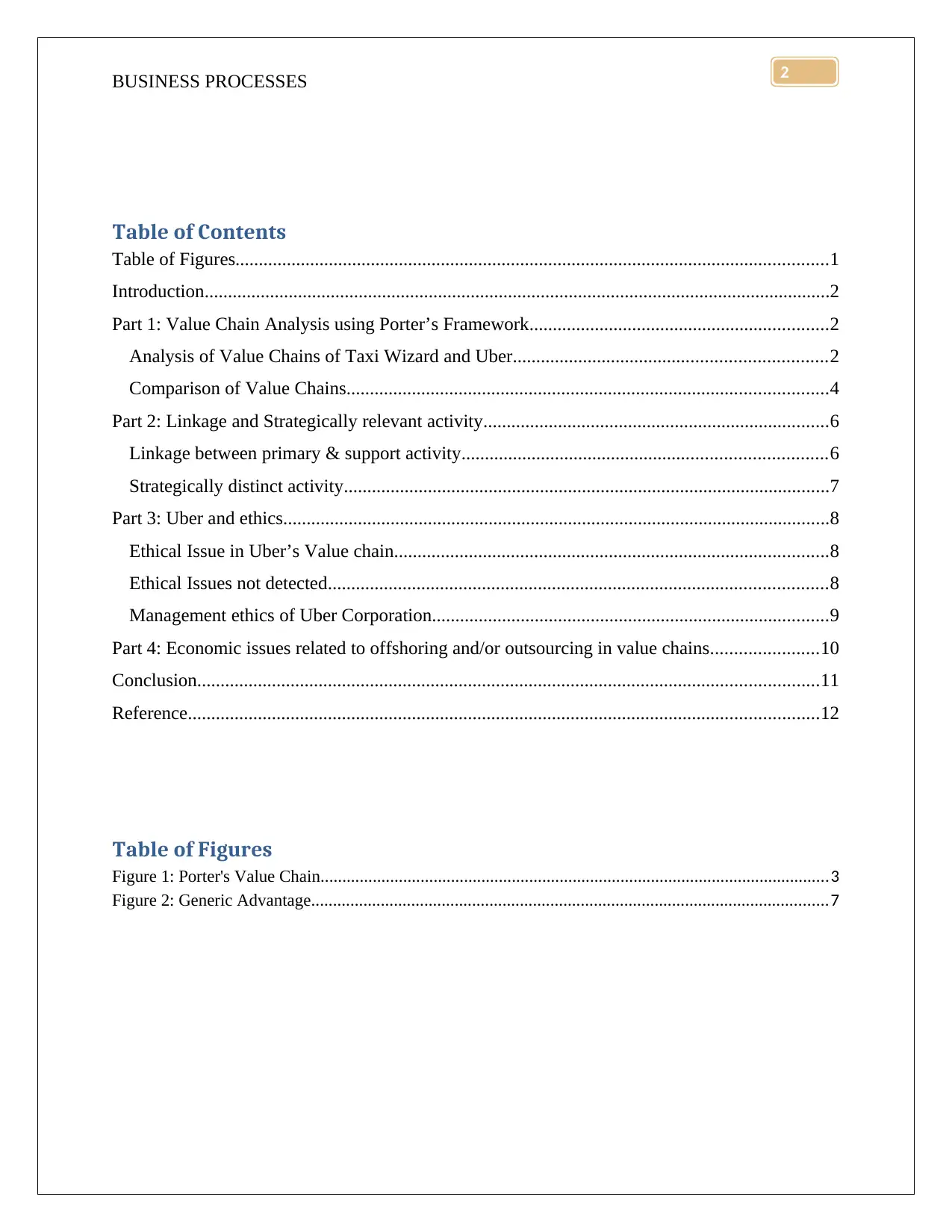
BUSINESS PROCESSES
Table of Contents
Table of Figures...............................................................................................................................1
Introduction......................................................................................................................................2
Part 1: Value Chain Analysis using Porter’s Framework................................................................2
Analysis of Value Chains of Taxi Wizard and Uber...................................................................2
Comparison of Value Chains.......................................................................................................4
Part 2: Linkage and Strategically relevant activity..........................................................................6
Linkage between primary & support activity..............................................................................6
Strategically distinct activity........................................................................................................7
Part 3: Uber and ethics.....................................................................................................................8
Ethical Issue in Uber’s Value chain.............................................................................................8
Ethical Issues not detected...........................................................................................................8
Management ethics of Uber Corporation.....................................................................................9
Part 4: Economic issues related to offshoring and/or outsourcing in value chains.......................10
Conclusion.....................................................................................................................................11
Reference.......................................................................................................................................12
Table of Figures
Figure 1: Porter's Value Chain.....................................................................................................................3
Figure 2: Generic Advantage.......................................................................................................................7
2
Table of Contents
Table of Figures...............................................................................................................................1
Introduction......................................................................................................................................2
Part 1: Value Chain Analysis using Porter’s Framework................................................................2
Analysis of Value Chains of Taxi Wizard and Uber...................................................................2
Comparison of Value Chains.......................................................................................................4
Part 2: Linkage and Strategically relevant activity..........................................................................6
Linkage between primary & support activity..............................................................................6
Strategically distinct activity........................................................................................................7
Part 3: Uber and ethics.....................................................................................................................8
Ethical Issue in Uber’s Value chain.............................................................................................8
Ethical Issues not detected...........................................................................................................8
Management ethics of Uber Corporation.....................................................................................9
Part 4: Economic issues related to offshoring and/or outsourcing in value chains.......................10
Conclusion.....................................................................................................................................11
Reference.......................................................................................................................................12
Table of Figures
Figure 1: Porter's Value Chain.....................................................................................................................3
Figure 2: Generic Advantage.......................................................................................................................7
2
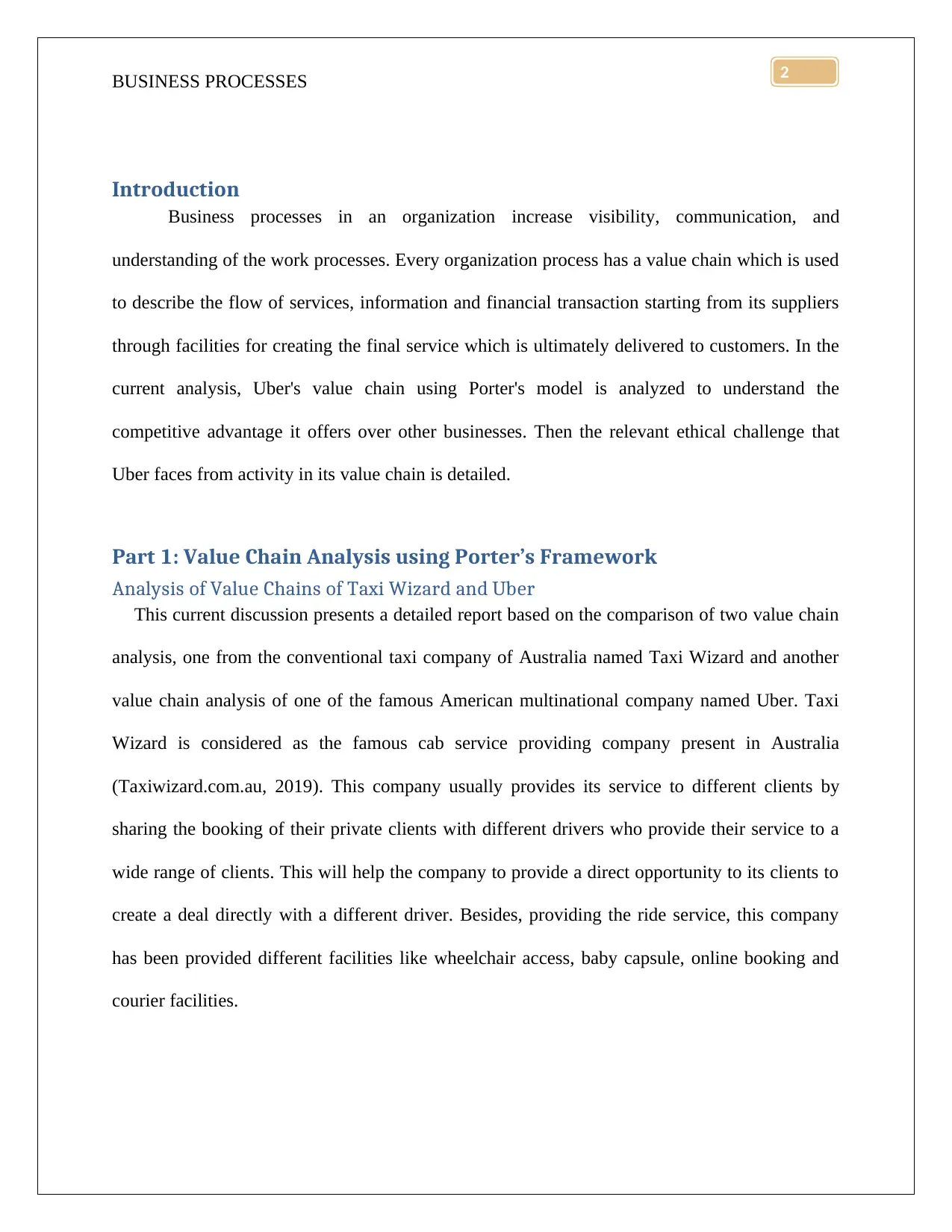
BUSINESS PROCESSES
Introduction
Business processes in an organization increase visibility, communication, and
understanding of the work processes. Every organization process has a value chain which is used
to describe the flow of services, information and financial transaction starting from its suppliers
through facilities for creating the final service which is ultimately delivered to customers. In the
current analysis, Uber's value chain using Porter's model is analyzed to understand the
competitive advantage it offers over other businesses. Then the relevant ethical challenge that
Uber faces from activity in its value chain is detailed.
Part 1: Value Chain Analysis using Porter’s Framework
Analysis of Value Chains of Taxi Wizard and Uber
This current discussion presents a detailed report based on the comparison of two value chain
analysis, one from the conventional taxi company of Australia named Taxi Wizard and another
value chain analysis of one of the famous American multinational company named Uber. Taxi
Wizard is considered as the famous cab service providing company present in Australia
(Taxiwizard.com.au, 2019). This company usually provides its service to different clients by
sharing the booking of their private clients with different drivers who provide their service to a
wide range of clients. This will help the company to provide a direct opportunity to its clients to
create a deal directly with a different driver. Besides, providing the ride service, this company
has been provided different facilities like wheelchair access, baby capsule, online booking and
courier facilities.
2
Introduction
Business processes in an organization increase visibility, communication, and
understanding of the work processes. Every organization process has a value chain which is used
to describe the flow of services, information and financial transaction starting from its suppliers
through facilities for creating the final service which is ultimately delivered to customers. In the
current analysis, Uber's value chain using Porter's model is analyzed to understand the
competitive advantage it offers over other businesses. Then the relevant ethical challenge that
Uber faces from activity in its value chain is detailed.
Part 1: Value Chain Analysis using Porter’s Framework
Analysis of Value Chains of Taxi Wizard and Uber
This current discussion presents a detailed report based on the comparison of two value chain
analysis, one from the conventional taxi company of Australia named Taxi Wizard and another
value chain analysis of one of the famous American multinational company named Uber. Taxi
Wizard is considered as the famous cab service providing company present in Australia
(Taxiwizard.com.au, 2019). This company usually provides its service to different clients by
sharing the booking of their private clients with different drivers who provide their service to a
wide range of clients. This will help the company to provide a direct opportunity to its clients to
create a deal directly with a different driver. Besides, providing the ride service, this company
has been provided different facilities like wheelchair access, baby capsule, online booking and
courier facilities.
2
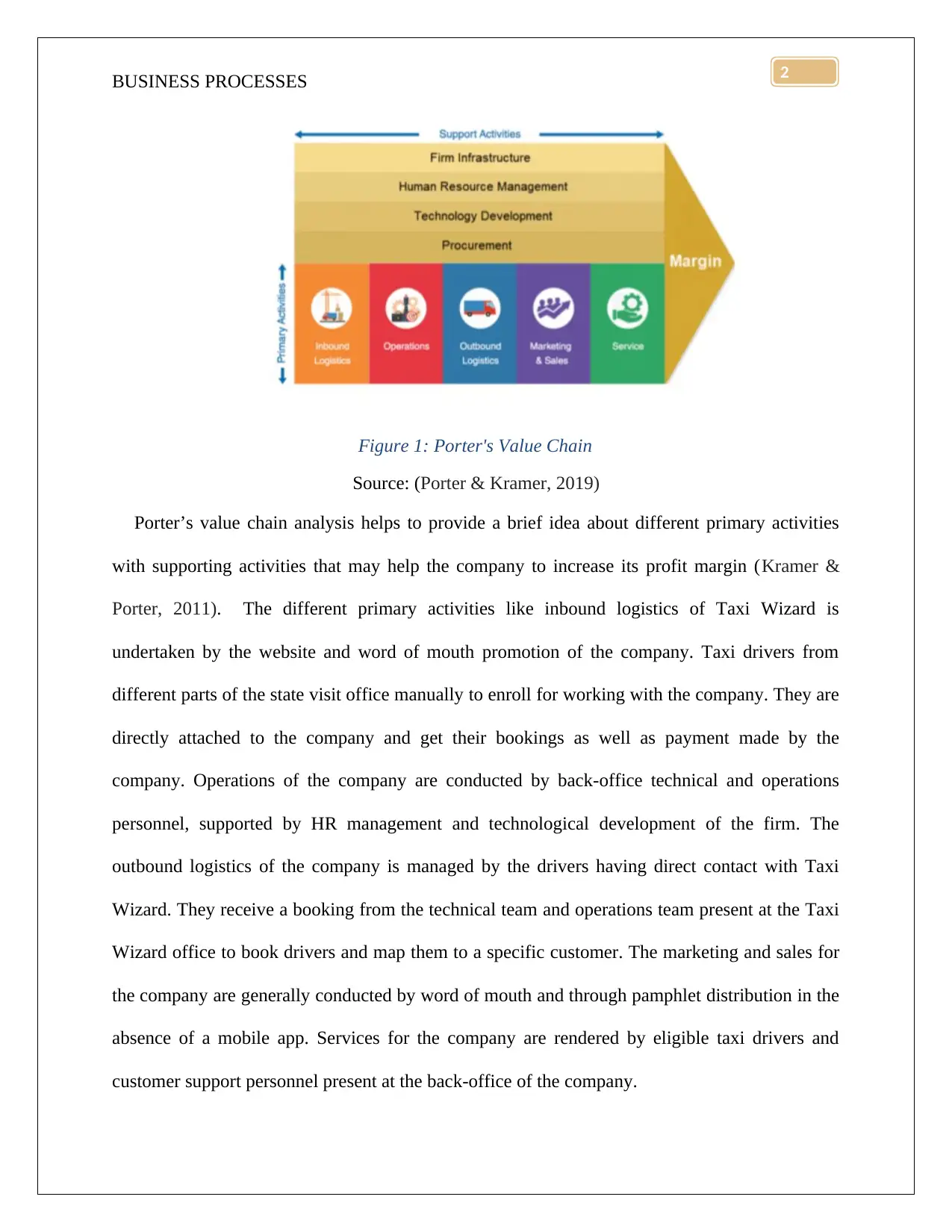
BUSINESS PROCESSES
Figure 1: Porter's Value Chain
Source: (Porter & Kramer, 2019)
Porter’s value chain analysis helps to provide a brief idea about different primary activities
with supporting activities that may help the company to increase its profit margin (Kramer &
Porter, 2011). The different primary activities like inbound logistics of Taxi Wizard is
undertaken by the website and word of mouth promotion of the company. Taxi drivers from
different parts of the state visit office manually to enroll for working with the company. They are
directly attached to the company and get their bookings as well as payment made by the
company. Operations of the company are conducted by back-office technical and operations
personnel, supported by HR management and technological development of the firm. The
outbound logistics of the company is managed by the drivers having direct contact with Taxi
Wizard. They receive a booking from the technical team and operations team present at the Taxi
Wizard office to book drivers and map them to a specific customer. The marketing and sales for
the company are generally conducted by word of mouth and through pamphlet distribution in the
absence of a mobile app. Services for the company are rendered by eligible taxi drivers and
customer support personnel present at the back-office of the company.
2
Figure 1: Porter's Value Chain
Source: (Porter & Kramer, 2019)
Porter’s value chain analysis helps to provide a brief idea about different primary activities
with supporting activities that may help the company to increase its profit margin (Kramer &
Porter, 2011). The different primary activities like inbound logistics of Taxi Wizard is
undertaken by the website and word of mouth promotion of the company. Taxi drivers from
different parts of the state visit office manually to enroll for working with the company. They are
directly attached to the company and get their bookings as well as payment made by the
company. Operations of the company are conducted by back-office technical and operations
personnel, supported by HR management and technological development of the firm. The
outbound logistics of the company is managed by the drivers having direct contact with Taxi
Wizard. They receive a booking from the technical team and operations team present at the Taxi
Wizard office to book drivers and map them to a specific customer. The marketing and sales for
the company are generally conducted by word of mouth and through pamphlet distribution in the
absence of a mobile app. Services for the company are rendered by eligible taxi drivers and
customer support personnel present at the back-office of the company.
2
Secure Best Marks with AI Grader
Need help grading? Try our AI Grader for instant feedback on your assignments.
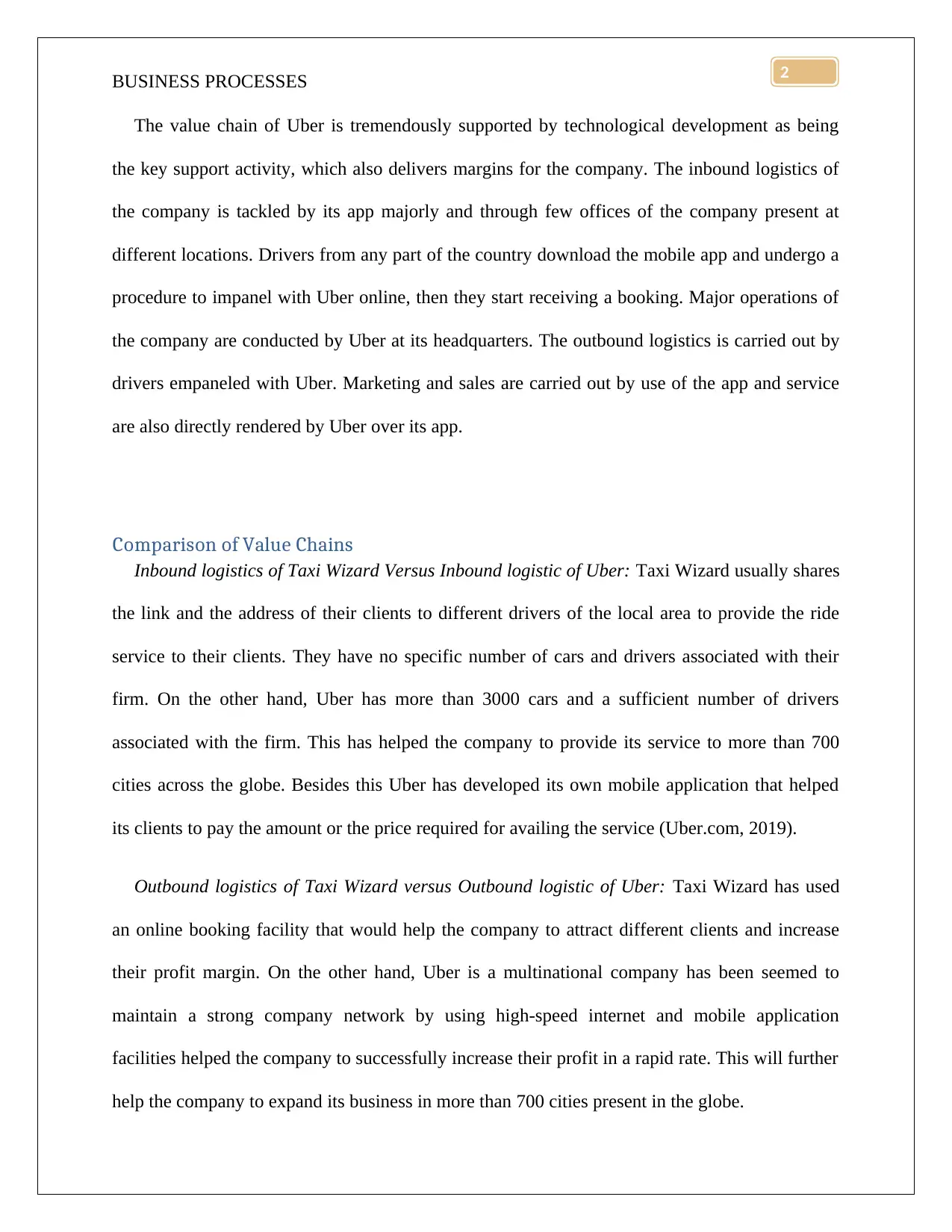
BUSINESS PROCESSES
The value chain of Uber is tremendously supported by technological development as being
the key support activity, which also delivers margins for the company. The inbound logistics of
the company is tackled by its app majorly and through few offices of the company present at
different locations. Drivers from any part of the country download the mobile app and undergo a
procedure to impanel with Uber online, then they start receiving a booking. Major operations of
the company are conducted by Uber at its headquarters. The outbound logistics is carried out by
drivers empaneled with Uber. Marketing and sales are carried out by use of the app and service
are also directly rendered by Uber over its app.
Comparison of Value Chains
Inbound logistics of Taxi Wizard Versus Inbound logistic of Uber: Taxi Wizard usually shares
the link and the address of their clients to different drivers of the local area to provide the ride
service to their clients. They have no specific number of cars and drivers associated with their
firm. On the other hand, Uber has more than 3000 cars and a sufficient number of drivers
associated with the firm. This has helped the company to provide its service to more than 700
cities across the globe. Besides this Uber has developed its own mobile application that helped
its clients to pay the amount or the price required for availing the service (Uber.com, 2019).
Outbound logistics of Taxi Wizard versus Outbound logistic of Uber: Taxi Wizard has used
an online booking facility that would help the company to attract different clients and increase
their profit margin. On the other hand, Uber is a multinational company has been seemed to
maintain a strong company network by using high-speed internet and mobile application
facilities helped the company to successfully increase their profit in a rapid rate. This will further
help the company to expand its business in more than 700 cities present in the globe.
2
The value chain of Uber is tremendously supported by technological development as being
the key support activity, which also delivers margins for the company. The inbound logistics of
the company is tackled by its app majorly and through few offices of the company present at
different locations. Drivers from any part of the country download the mobile app and undergo a
procedure to impanel with Uber online, then they start receiving a booking. Major operations of
the company are conducted by Uber at its headquarters. The outbound logistics is carried out by
drivers empaneled with Uber. Marketing and sales are carried out by use of the app and service
are also directly rendered by Uber over its app.
Comparison of Value Chains
Inbound logistics of Taxi Wizard Versus Inbound logistic of Uber: Taxi Wizard usually shares
the link and the address of their clients to different drivers of the local area to provide the ride
service to their clients. They have no specific number of cars and drivers associated with their
firm. On the other hand, Uber has more than 3000 cars and a sufficient number of drivers
associated with the firm. This has helped the company to provide its service to more than 700
cities across the globe. Besides this Uber has developed its own mobile application that helped
its clients to pay the amount or the price required for availing the service (Uber.com, 2019).
Outbound logistics of Taxi Wizard versus Outbound logistic of Uber: Taxi Wizard has used
an online booking facility that would help the company to attract different clients and increase
their profit margin. On the other hand, Uber is a multinational company has been seemed to
maintain a strong company network by using high-speed internet and mobile application
facilities helped the company to successfully increase their profit in a rapid rate. This will further
help the company to expand its business in more than 700 cities present in the globe.
2
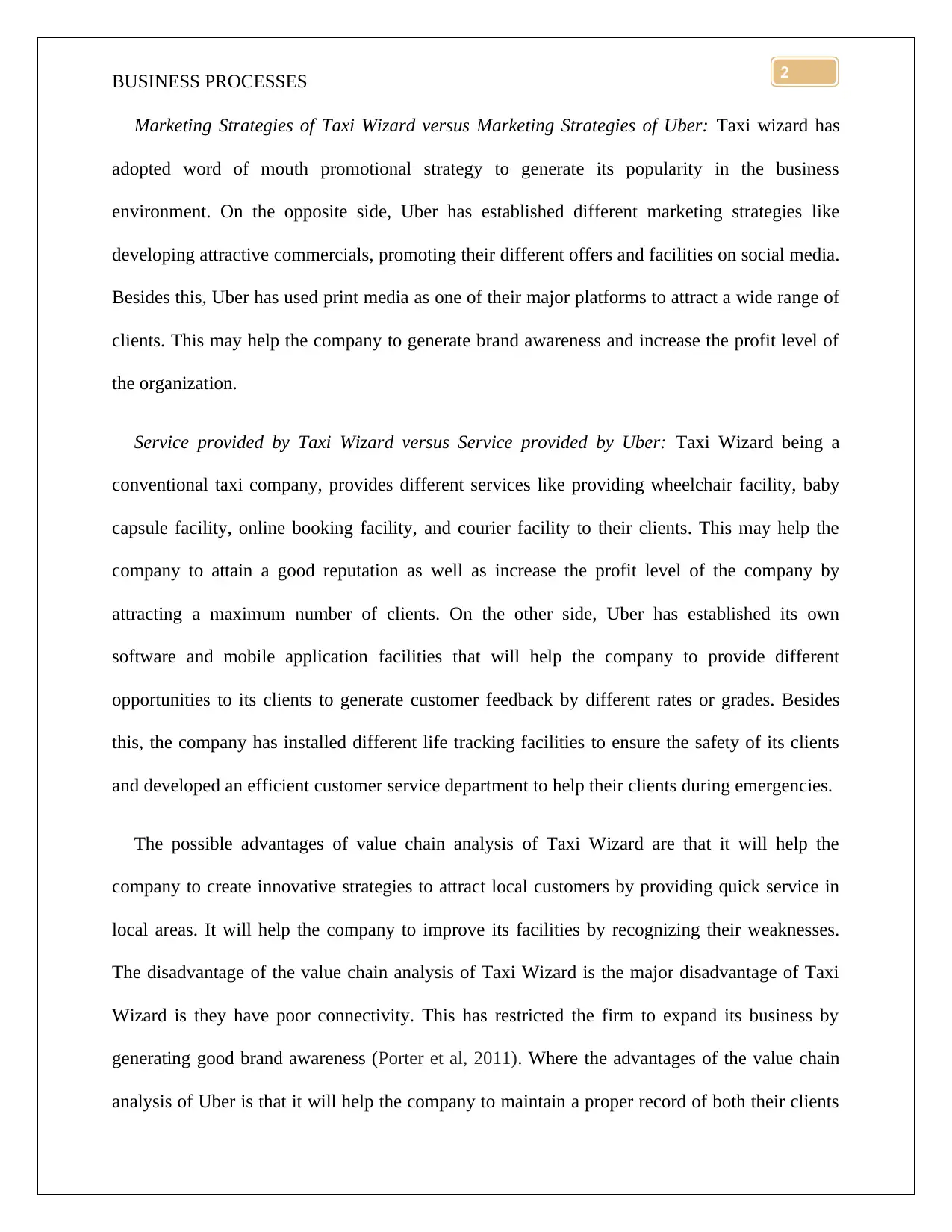
BUSINESS PROCESSES
Marketing Strategies of Taxi Wizard versus Marketing Strategies of Uber: Taxi wizard has
adopted word of mouth promotional strategy to generate its popularity in the business
environment. On the opposite side, Uber has established different marketing strategies like
developing attractive commercials, promoting their different offers and facilities on social media.
Besides this, Uber has used print media as one of their major platforms to attract a wide range of
clients. This may help the company to generate brand awareness and increase the profit level of
the organization.
Service provided by Taxi Wizard versus Service provided by Uber: Taxi Wizard being a
conventional taxi company, provides different services like providing wheelchair facility, baby
capsule facility, online booking facility, and courier facility to their clients. This may help the
company to attain a good reputation as well as increase the profit level of the company by
attracting a maximum number of clients. On the other side, Uber has established its own
software and mobile application facilities that will help the company to provide different
opportunities to its clients to generate customer feedback by different rates or grades. Besides
this, the company has installed different life tracking facilities to ensure the safety of its clients
and developed an efficient customer service department to help their clients during emergencies.
The possible advantages of value chain analysis of Taxi Wizard are that it will help the
company to create innovative strategies to attract local customers by providing quick service in
local areas. It will help the company to improve its facilities by recognizing their weaknesses.
The disadvantage of the value chain analysis of Taxi Wizard is the major disadvantage of Taxi
Wizard is they have poor connectivity. This has restricted the firm to expand its business by
generating good brand awareness (Porter et al, 2011). Where the advantages of the value chain
analysis of Uber is that it will help the company to maintain a proper record of both their clients
2
Marketing Strategies of Taxi Wizard versus Marketing Strategies of Uber: Taxi wizard has
adopted word of mouth promotional strategy to generate its popularity in the business
environment. On the opposite side, Uber has established different marketing strategies like
developing attractive commercials, promoting their different offers and facilities on social media.
Besides this, Uber has used print media as one of their major platforms to attract a wide range of
clients. This may help the company to generate brand awareness and increase the profit level of
the organization.
Service provided by Taxi Wizard versus Service provided by Uber: Taxi Wizard being a
conventional taxi company, provides different services like providing wheelchair facility, baby
capsule facility, online booking facility, and courier facility to their clients. This may help the
company to attain a good reputation as well as increase the profit level of the company by
attracting a maximum number of clients. On the other side, Uber has established its own
software and mobile application facilities that will help the company to provide different
opportunities to its clients to generate customer feedback by different rates or grades. Besides
this, the company has installed different life tracking facilities to ensure the safety of its clients
and developed an efficient customer service department to help their clients during emergencies.
The possible advantages of value chain analysis of Taxi Wizard are that it will help the
company to create innovative strategies to attract local customers by providing quick service in
local areas. It will help the company to improve its facilities by recognizing their weaknesses.
The disadvantage of the value chain analysis of Taxi Wizard is the major disadvantage of Taxi
Wizard is they have poor connectivity. This has restricted the firm to expand its business by
generating good brand awareness (Porter et al, 2011). Where the advantages of the value chain
analysis of Uber is that it will help the company to maintain a proper record of both their clients
2
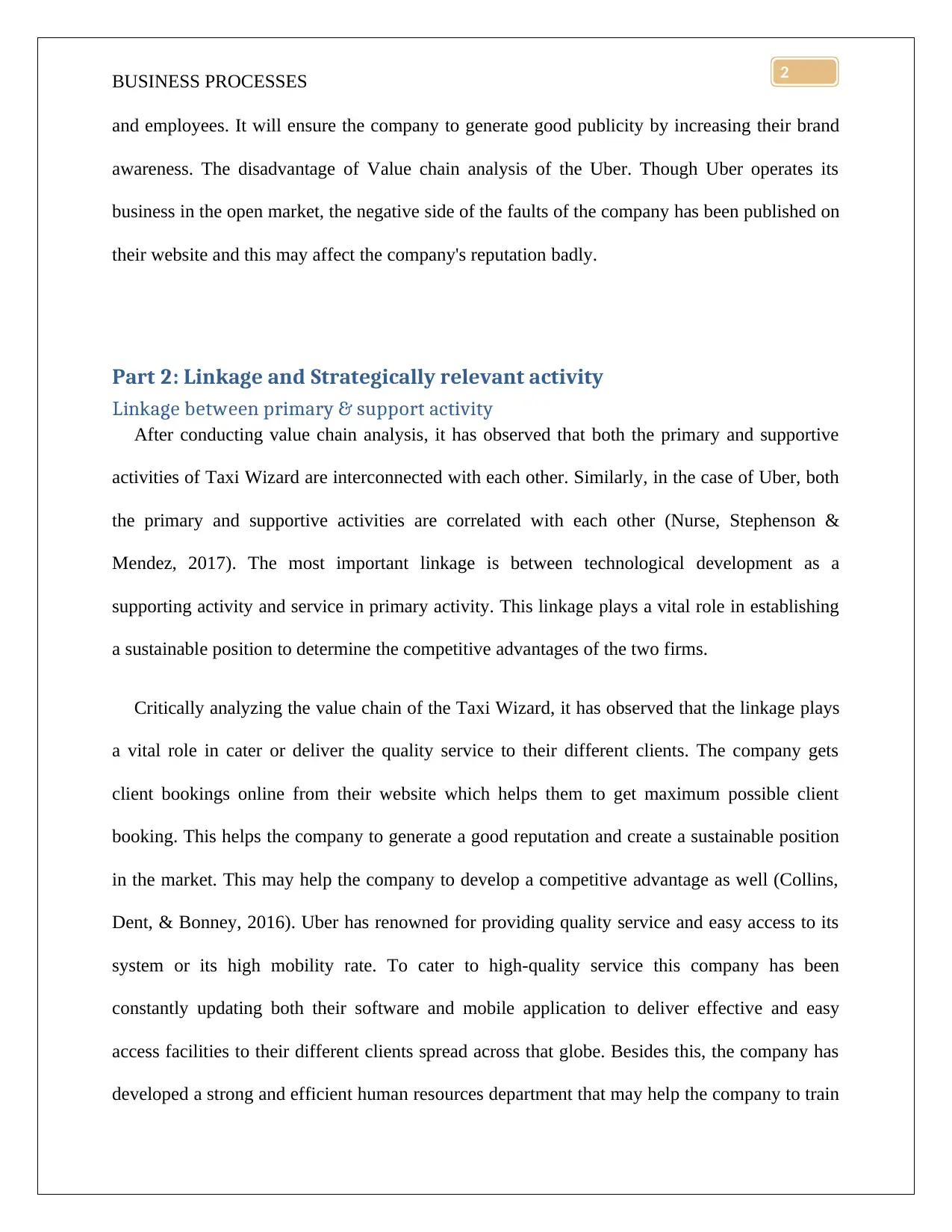
BUSINESS PROCESSES
and employees. It will ensure the company to generate good publicity by increasing their brand
awareness. The disadvantage of Value chain analysis of the Uber. Though Uber operates its
business in the open market, the negative side of the faults of the company has been published on
their website and this may affect the company's reputation badly.
Part 2: Linkage and Strategically relevant activity
Linkage between primary & support activity
After conducting value chain analysis, it has observed that both the primary and supportive
activities of Taxi Wizard are interconnected with each other. Similarly, in the case of Uber, both
the primary and supportive activities are correlated with each other (Nurse, Stephenson &
Mendez, 2017). The most important linkage is between technological development as a
supporting activity and service in primary activity. This linkage plays a vital role in establishing
a sustainable position to determine the competitive advantages of the two firms.
Critically analyzing the value chain of the Taxi Wizard, it has observed that the linkage plays
a vital role in cater or deliver the quality service to their different clients. The company gets
client bookings online from their website which helps them to get maximum possible client
booking. This helps the company to generate a good reputation and create a sustainable position
in the market. This may help the company to develop a competitive advantage as well (Collins,
Dent, & Bonney, 2016). Uber has renowned for providing quality service and easy access to its
system or its high mobility rate. To cater to high-quality service this company has been
constantly updating both their software and mobile application to deliver effective and easy
access facilities to their different clients spread across that globe. Besides this, the company has
developed a strong and efficient human resources department that may help the company to train
2
and employees. It will ensure the company to generate good publicity by increasing their brand
awareness. The disadvantage of Value chain analysis of the Uber. Though Uber operates its
business in the open market, the negative side of the faults of the company has been published on
their website and this may affect the company's reputation badly.
Part 2: Linkage and Strategically relevant activity
Linkage between primary & support activity
After conducting value chain analysis, it has observed that both the primary and supportive
activities of Taxi Wizard are interconnected with each other. Similarly, in the case of Uber, both
the primary and supportive activities are correlated with each other (Nurse, Stephenson &
Mendez, 2017). The most important linkage is between technological development as a
supporting activity and service in primary activity. This linkage plays a vital role in establishing
a sustainable position to determine the competitive advantages of the two firms.
Critically analyzing the value chain of the Taxi Wizard, it has observed that the linkage plays
a vital role in cater or deliver the quality service to their different clients. The company gets
client bookings online from their website which helps them to get maximum possible client
booking. This helps the company to generate a good reputation and create a sustainable position
in the market. This may help the company to develop a competitive advantage as well (Collins,
Dent, & Bonney, 2016). Uber has renowned for providing quality service and easy access to its
system or its high mobility rate. To cater to high-quality service this company has been
constantly updating both their software and mobile application to deliver effective and easy
access facilities to their different clients spread across that globe. Besides this, the company has
developed a strong and efficient human resources department that may help the company to train
2
Paraphrase This Document
Need a fresh take? Get an instant paraphrase of this document with our AI Paraphraser
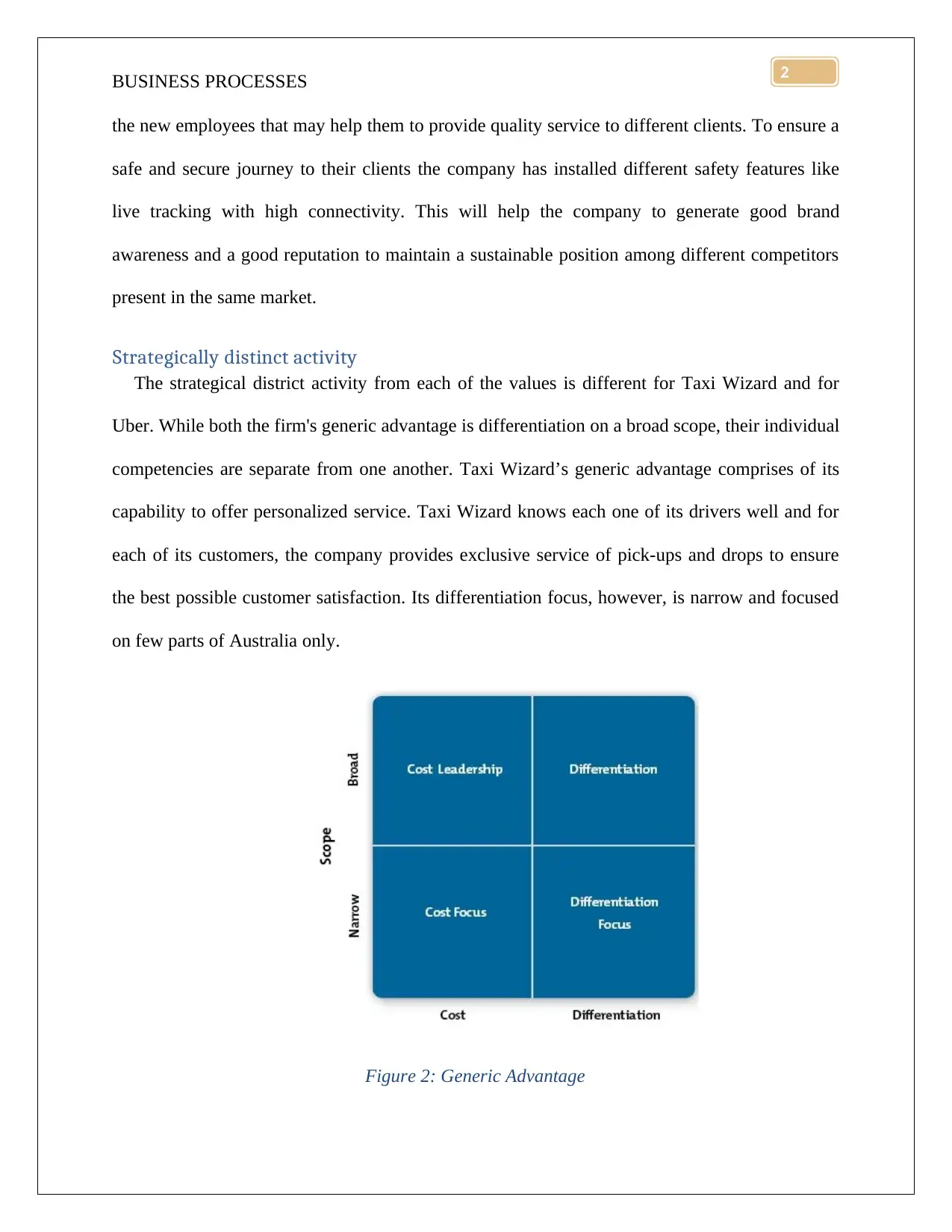
BUSINESS PROCESSES
the new employees that may help them to provide quality service to different clients. To ensure a
safe and secure journey to their clients the company has installed different safety features like
live tracking with high connectivity. This will help the company to generate good brand
awareness and a good reputation to maintain a sustainable position among different competitors
present in the same market.
Strategically distinct activity
The strategical district activity from each of the values is different for Taxi Wizard and for
Uber. While both the firm's generic advantage is differentiation on a broad scope, their individual
competencies are separate from one another. Taxi Wizard’s generic advantage comprises of its
capability to offer personalized service. Taxi Wizard knows each one of its drivers well and for
each of its customers, the company provides exclusive service of pick-ups and drops to ensure
the best possible customer satisfaction. Its differentiation focus, however, is narrow and focused
on few parts of Australia only.
Figure 2: Generic Advantage
2
the new employees that may help them to provide quality service to different clients. To ensure a
safe and secure journey to their clients the company has installed different safety features like
live tracking with high connectivity. This will help the company to generate good brand
awareness and a good reputation to maintain a sustainable position among different competitors
present in the same market.
Strategically distinct activity
The strategical district activity from each of the values is different for Taxi Wizard and for
Uber. While both the firm's generic advantage is differentiation on a broad scope, their individual
competencies are separate from one another. Taxi Wizard’s generic advantage comprises of its
capability to offer personalized service. Taxi Wizard knows each one of its drivers well and for
each of its customers, the company provides exclusive service of pick-ups and drops to ensure
the best possible customer satisfaction. Its differentiation focus, however, is narrow and focused
on few parts of Australia only.
Figure 2: Generic Advantage
2
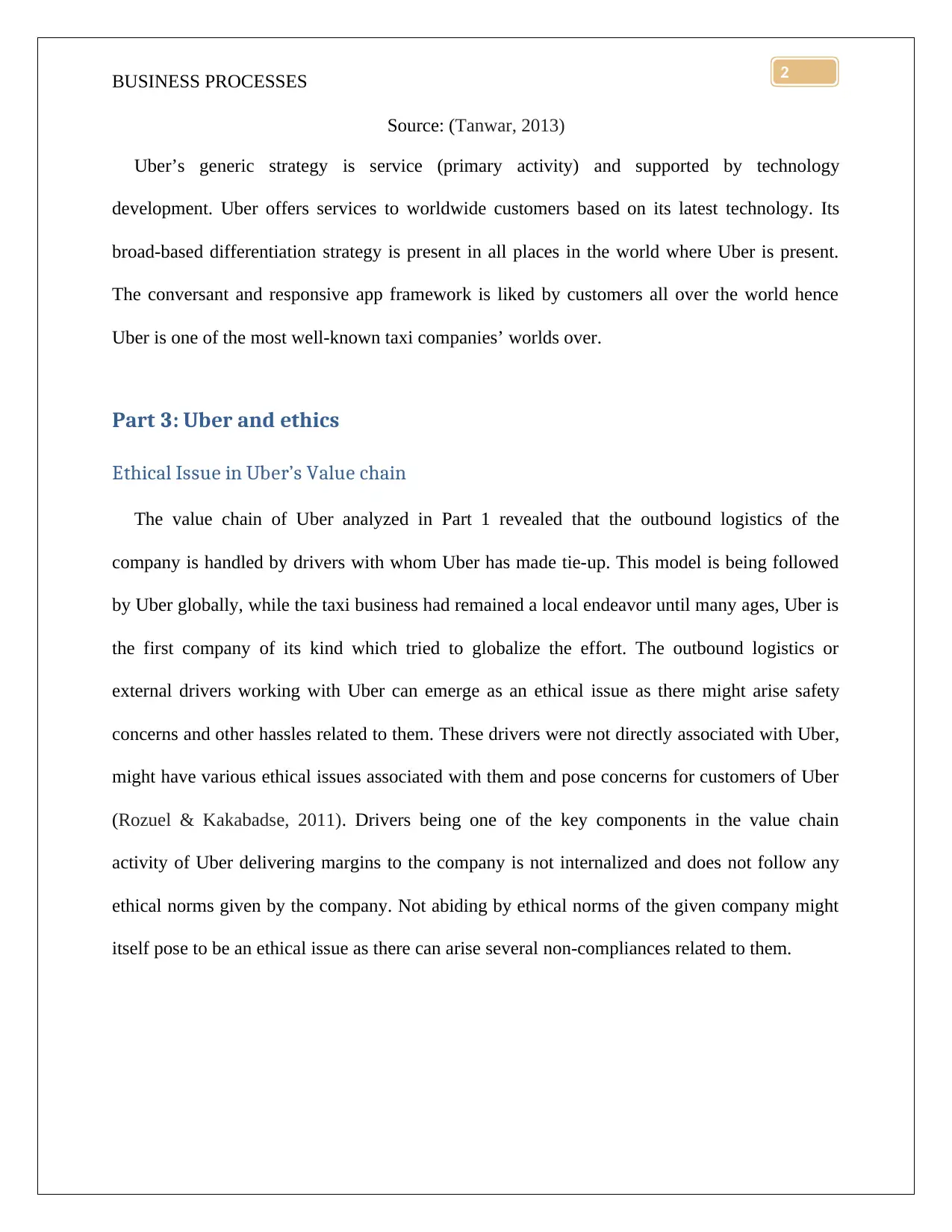
BUSINESS PROCESSES
Source: (Tanwar, 2013)
Uber’s generic strategy is service (primary activity) and supported by technology
development. Uber offers services to worldwide customers based on its latest technology. Its
broad-based differentiation strategy is present in all places in the world where Uber is present.
The conversant and responsive app framework is liked by customers all over the world hence
Uber is one of the most well-known taxi companies’ worlds over.
Part 3: Uber and ethics
Ethical Issue in Uber’s Value chain
The value chain of Uber analyzed in Part 1 revealed that the outbound logistics of the
company is handled by drivers with whom Uber has made tie-up. This model is being followed
by Uber globally, while the taxi business had remained a local endeavor until many ages, Uber is
the first company of its kind which tried to globalize the effort. The outbound logistics or
external drivers working with Uber can emerge as an ethical issue as there might arise safety
concerns and other hassles related to them. These drivers were not directly associated with Uber,
might have various ethical issues associated with them and pose concerns for customers of Uber
(Rozuel & Kakabadse, 2011). Drivers being one of the key components in the value chain
activity of Uber delivering margins to the company is not internalized and does not follow any
ethical norms given by the company. Not abiding by ethical norms of the given company might
itself pose to be an ethical issue as there can arise several non-compliances related to them.
2
Source: (Tanwar, 2013)
Uber’s generic strategy is service (primary activity) and supported by technology
development. Uber offers services to worldwide customers based on its latest technology. Its
broad-based differentiation strategy is present in all places in the world where Uber is present.
The conversant and responsive app framework is liked by customers all over the world hence
Uber is one of the most well-known taxi companies’ worlds over.
Part 3: Uber and ethics
Ethical Issue in Uber’s Value chain
The value chain of Uber analyzed in Part 1 revealed that the outbound logistics of the
company is handled by drivers with whom Uber has made tie-up. This model is being followed
by Uber globally, while the taxi business had remained a local endeavor until many ages, Uber is
the first company of its kind which tried to globalize the effort. The outbound logistics or
external drivers working with Uber can emerge as an ethical issue as there might arise safety
concerns and other hassles related to them. These drivers were not directly associated with Uber,
might have various ethical issues associated with them and pose concerns for customers of Uber
(Rozuel & Kakabadse, 2011). Drivers being one of the key components in the value chain
activity of Uber delivering margins to the company is not internalized and does not follow any
ethical norms given by the company. Not abiding by ethical norms of the given company might
itself pose to be an ethical issue as there can arise several non-compliances related to them.
2
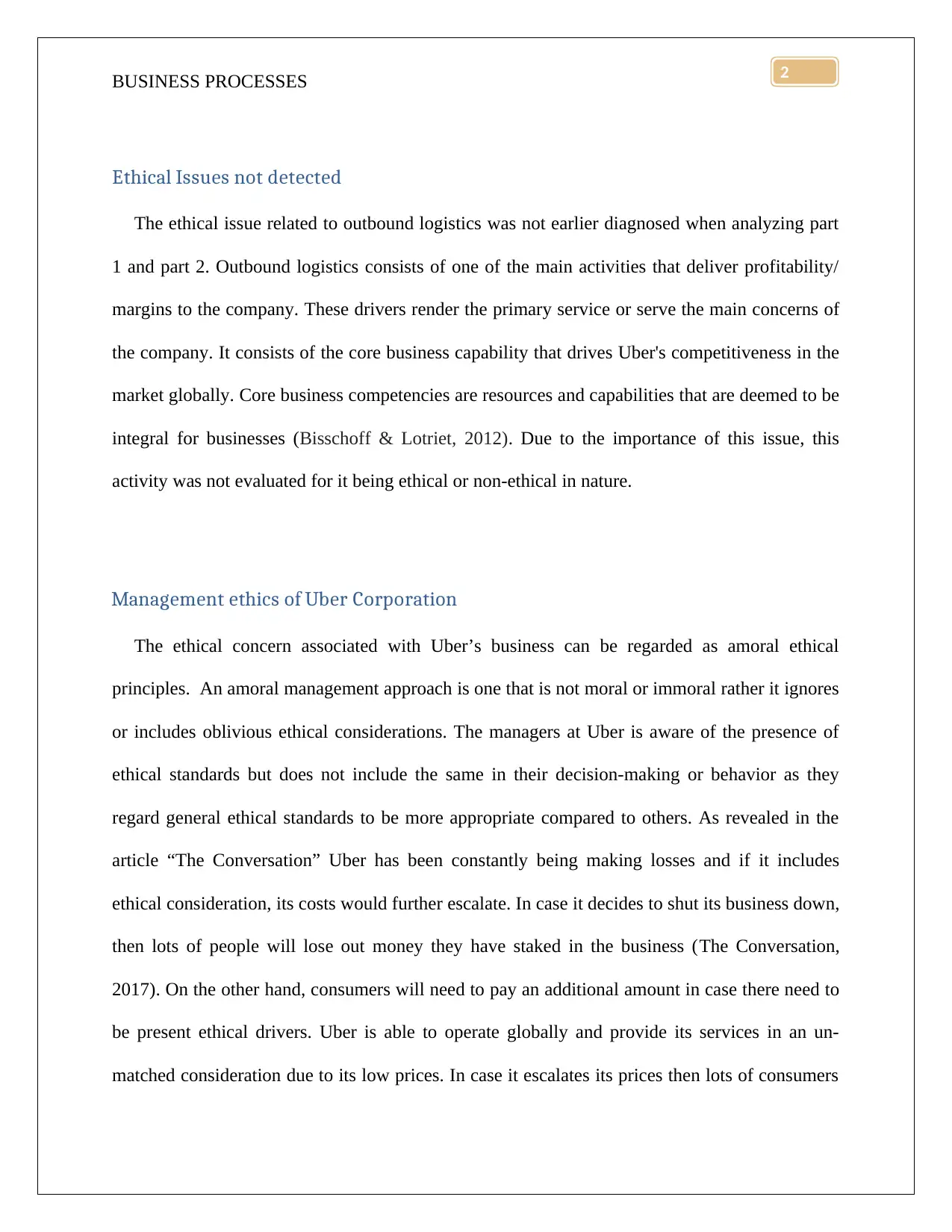
BUSINESS PROCESSES
Ethical Issues not detected
The ethical issue related to outbound logistics was not earlier diagnosed when analyzing part
1 and part 2. Outbound logistics consists of one of the main activities that deliver profitability/
margins to the company. These drivers render the primary service or serve the main concerns of
the company. It consists of the core business capability that drives Uber's competitiveness in the
market globally. Core business competencies are resources and capabilities that are deemed to be
integral for businesses (Bisschoff & Lotriet, 2012). Due to the importance of this issue, this
activity was not evaluated for it being ethical or non-ethical in nature.
Management ethics of Uber Corporation
The ethical concern associated with Uber’s business can be regarded as amoral ethical
principles. An amoral management approach is one that is not moral or immoral rather it ignores
or includes oblivious ethical considerations. The managers at Uber is aware of the presence of
ethical standards but does not include the same in their decision-making or behavior as they
regard general ethical standards to be more appropriate compared to others. As revealed in the
article “The Conversation” Uber has been constantly being making losses and if it includes
ethical consideration, its costs would further escalate. In case it decides to shut its business down,
then lots of people will lose out money they have staked in the business (The Conversation,
2017). On the other hand, consumers will need to pay an additional amount in case there need to
be present ethical drivers. Uber is able to operate globally and provide its services in an un-
matched consideration due to its low prices. In case it escalates its prices then lots of consumers
2
Ethical Issues not detected
The ethical issue related to outbound logistics was not earlier diagnosed when analyzing part
1 and part 2. Outbound logistics consists of one of the main activities that deliver profitability/
margins to the company. These drivers render the primary service or serve the main concerns of
the company. It consists of the core business capability that drives Uber's competitiveness in the
market globally. Core business competencies are resources and capabilities that are deemed to be
integral for businesses (Bisschoff & Lotriet, 2012). Due to the importance of this issue, this
activity was not evaluated for it being ethical or non-ethical in nature.
Management ethics of Uber Corporation
The ethical concern associated with Uber’s business can be regarded as amoral ethical
principles. An amoral management approach is one that is not moral or immoral rather it ignores
or includes oblivious ethical considerations. The managers at Uber is aware of the presence of
ethical standards but does not include the same in their decision-making or behavior as they
regard general ethical standards to be more appropriate compared to others. As revealed in the
article “The Conversation” Uber has been constantly being making losses and if it includes
ethical consideration, its costs would further escalate. In case it decides to shut its business down,
then lots of people will lose out money they have staked in the business (The Conversation,
2017). On the other hand, consumers will need to pay an additional amount in case there need to
be present ethical drivers. Uber is able to operate globally and provide its services in an un-
matched consideration due to its low prices. In case it escalates its prices then lots of consumers
2
Secure Best Marks with AI Grader
Need help grading? Try our AI Grader for instant feedback on your assignments.
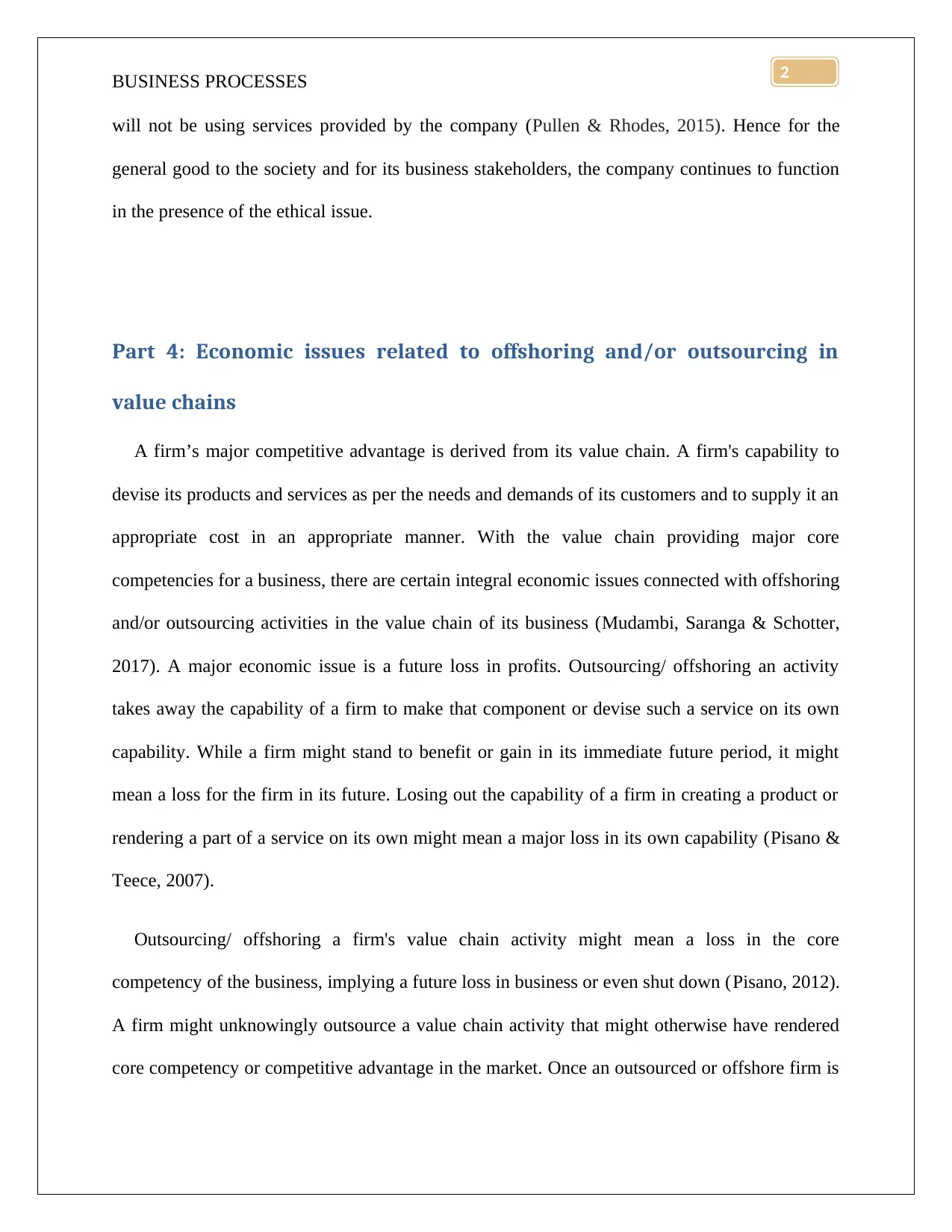
BUSINESS PROCESSES
will not be using services provided by the company (Pullen & Rhodes, 2015). Hence for the
general good to the society and for its business stakeholders, the company continues to function
in the presence of the ethical issue.
Part 4: Economic issues related to offshoring and/or outsourcing in
value chains
A firm’s major competitive advantage is derived from its value chain. A firm's capability to
devise its products and services as per the needs and demands of its customers and to supply it an
appropriate cost in an appropriate manner. With the value chain providing major core
competencies for a business, there are certain integral economic issues connected with offshoring
and/or outsourcing activities in the value chain of its business (Mudambi, Saranga & Schotter,
2017). A major economic issue is a future loss in profits. Outsourcing/ offshoring an activity
takes away the capability of a firm to make that component or devise such a service on its own
capability. While a firm might stand to benefit or gain in its immediate future period, it might
mean a loss for the firm in its future. Losing out the capability of a firm in creating a product or
rendering a part of a service on its own might mean a major loss in its own capability (Pisano &
Teece, 2007).
Outsourcing/ offshoring a firm's value chain activity might mean a loss in the core
competency of the business, implying a future loss in business or even shut down (Pisano, 2012).
A firm might unknowingly outsource a value chain activity that might otherwise have rendered
core competency or competitive advantage in the market. Once an outsourced or offshore firm is
2
will not be using services provided by the company (Pullen & Rhodes, 2015). Hence for the
general good to the society and for its business stakeholders, the company continues to function
in the presence of the ethical issue.
Part 4: Economic issues related to offshoring and/or outsourcing in
value chains
A firm’s major competitive advantage is derived from its value chain. A firm's capability to
devise its products and services as per the needs and demands of its customers and to supply it an
appropriate cost in an appropriate manner. With the value chain providing major core
competencies for a business, there are certain integral economic issues connected with offshoring
and/or outsourcing activities in the value chain of its business (Mudambi, Saranga & Schotter,
2017). A major economic issue is a future loss in profits. Outsourcing/ offshoring an activity
takes away the capability of a firm to make that component or devise such a service on its own
capability. While a firm might stand to benefit or gain in its immediate future period, it might
mean a loss for the firm in its future. Losing out the capability of a firm in creating a product or
rendering a part of a service on its own might mean a major loss in its own capability (Pisano &
Teece, 2007).
Outsourcing/ offshoring a firm's value chain activity might mean a loss in the core
competency of the business, implying a future loss in business or even shut down (Pisano, 2012).
A firm might unknowingly outsource a value chain activity that might otherwise have rendered
core competency or competitive advantage in the market. Once an outsourced or offshore firm is
2
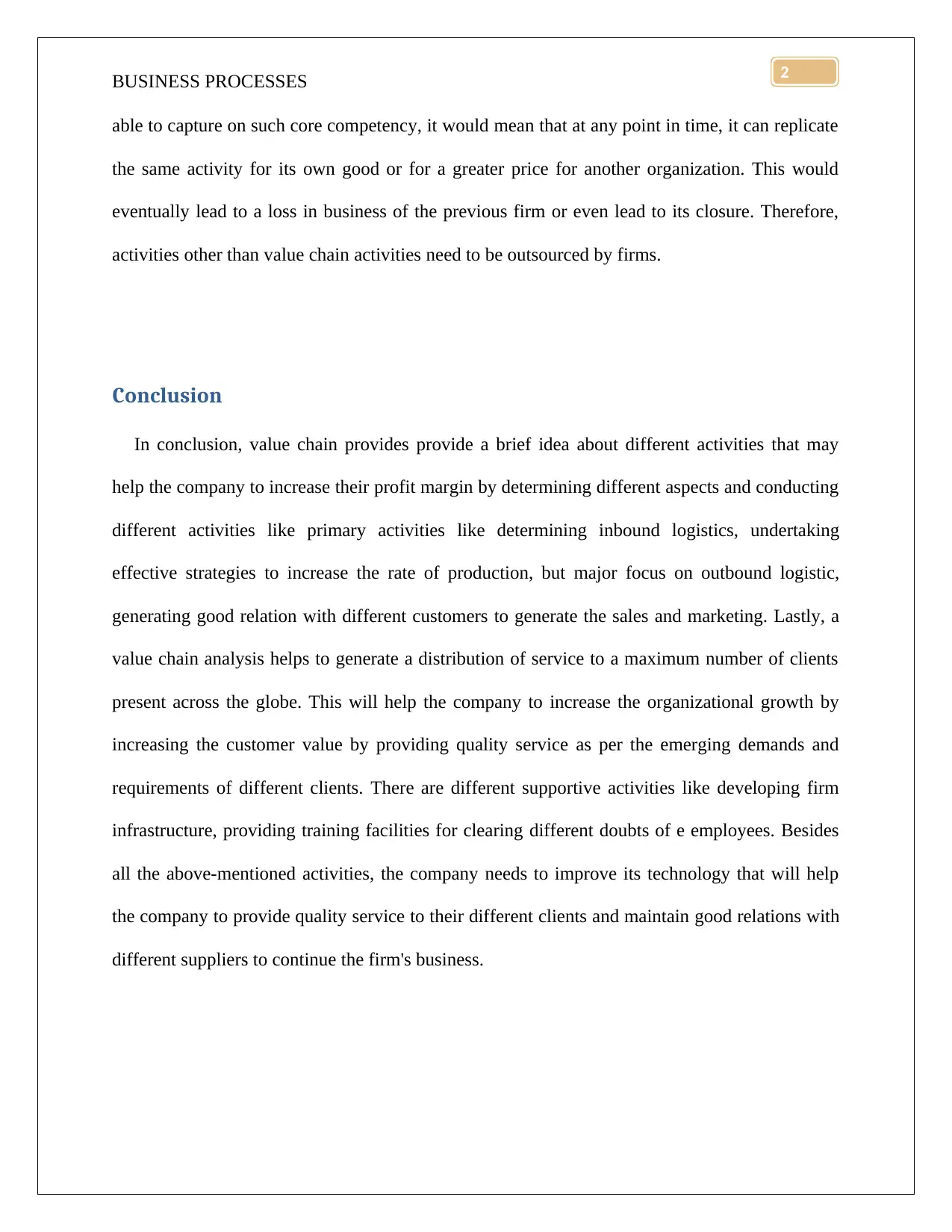
BUSINESS PROCESSES
able to capture on such core competency, it would mean that at any point in time, it can replicate
the same activity for its own good or for a greater price for another organization. This would
eventually lead to a loss in business of the previous firm or even lead to its closure. Therefore,
activities other than value chain activities need to be outsourced by firms.
Conclusion
In conclusion, value chain provides provide a brief idea about different activities that may
help the company to increase their profit margin by determining different aspects and conducting
different activities like primary activities like determining inbound logistics, undertaking
effective strategies to increase the rate of production, but major focus on outbound logistic,
generating good relation with different customers to generate the sales and marketing. Lastly, a
value chain analysis helps to generate a distribution of service to a maximum number of clients
present across the globe. This will help the company to increase the organizational growth by
increasing the customer value by providing quality service as per the emerging demands and
requirements of different clients. There are different supportive activities like developing firm
infrastructure, providing training facilities for clearing different doubts of e employees. Besides
all the above-mentioned activities, the company needs to improve its technology that will help
the company to provide quality service to their different clients and maintain good relations with
different suppliers to continue the firm's business.
2
able to capture on such core competency, it would mean that at any point in time, it can replicate
the same activity for its own good or for a greater price for another organization. This would
eventually lead to a loss in business of the previous firm or even lead to its closure. Therefore,
activities other than value chain activities need to be outsourced by firms.
Conclusion
In conclusion, value chain provides provide a brief idea about different activities that may
help the company to increase their profit margin by determining different aspects and conducting
different activities like primary activities like determining inbound logistics, undertaking
effective strategies to increase the rate of production, but major focus on outbound logistic,
generating good relation with different customers to generate the sales and marketing. Lastly, a
value chain analysis helps to generate a distribution of service to a maximum number of clients
present across the globe. This will help the company to increase the organizational growth by
increasing the customer value by providing quality service as per the emerging demands and
requirements of different clients. There are different supportive activities like developing firm
infrastructure, providing training facilities for clearing different doubts of e employees. Besides
all the above-mentioned activities, the company needs to improve its technology that will help
the company to provide quality service to their different clients and maintain good relations with
different suppliers to continue the firm's business.
2
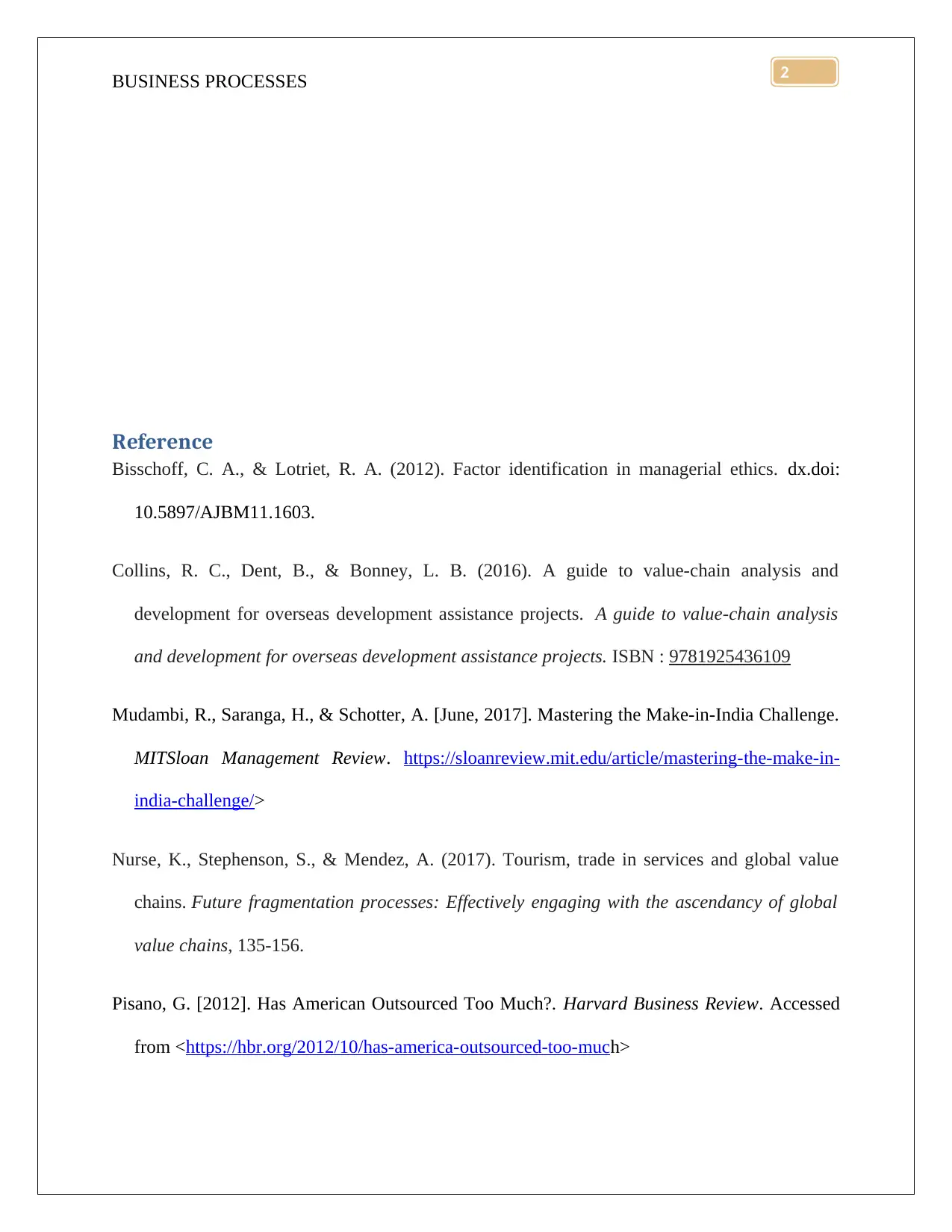
BUSINESS PROCESSES
Reference
Bisschoff, C. A., & Lotriet, R. A. (2012). Factor identification in managerial ethics. dx.doi:
10.5897/AJBM11.1603.
Collins, R. C., Dent, B., & Bonney, L. B. (2016). A guide to value-chain analysis and
development for overseas development assistance projects. A guide to value-chain analysis
and development for overseas development assistance projects. ISBN : 9781925436109
Mudambi, R., Saranga, H., & Schotter, A. [June, 2017]. Mastering the Make-in-India Challenge.
MITSloan Management Review. https://sloanreview.mit.edu/article/mastering-the-make-in-
india-challenge/>
Nurse, K., Stephenson, S., & Mendez, A. (2017). Tourism, trade in services and global value
chains. Future fragmentation processes: Effectively engaging with the ascendancy of global
value chains, 135-156.
Pisano, G. [2012]. Has American Outsourced Too Much?. Harvard Business Review. Accessed
from <https://hbr.org/2012/10/has-america-outsourced-too-much>
2
Reference
Bisschoff, C. A., & Lotriet, R. A. (2012). Factor identification in managerial ethics. dx.doi:
10.5897/AJBM11.1603.
Collins, R. C., Dent, B., & Bonney, L. B. (2016). A guide to value-chain analysis and
development for overseas development assistance projects. A guide to value-chain analysis
and development for overseas development assistance projects. ISBN : 9781925436109
Mudambi, R., Saranga, H., & Schotter, A. [June, 2017]. Mastering the Make-in-India Challenge.
MITSloan Management Review. https://sloanreview.mit.edu/article/mastering-the-make-in-
india-challenge/>
Nurse, K., Stephenson, S., & Mendez, A. (2017). Tourism, trade in services and global value
chains. Future fragmentation processes: Effectively engaging with the ascendancy of global
value chains, 135-156.
Pisano, G. [2012]. Has American Outsourced Too Much?. Harvard Business Review. Accessed
from <https://hbr.org/2012/10/has-america-outsourced-too-much>
2
Paraphrase This Document
Need a fresh take? Get an instant paraphrase of this document with our AI Paraphraser
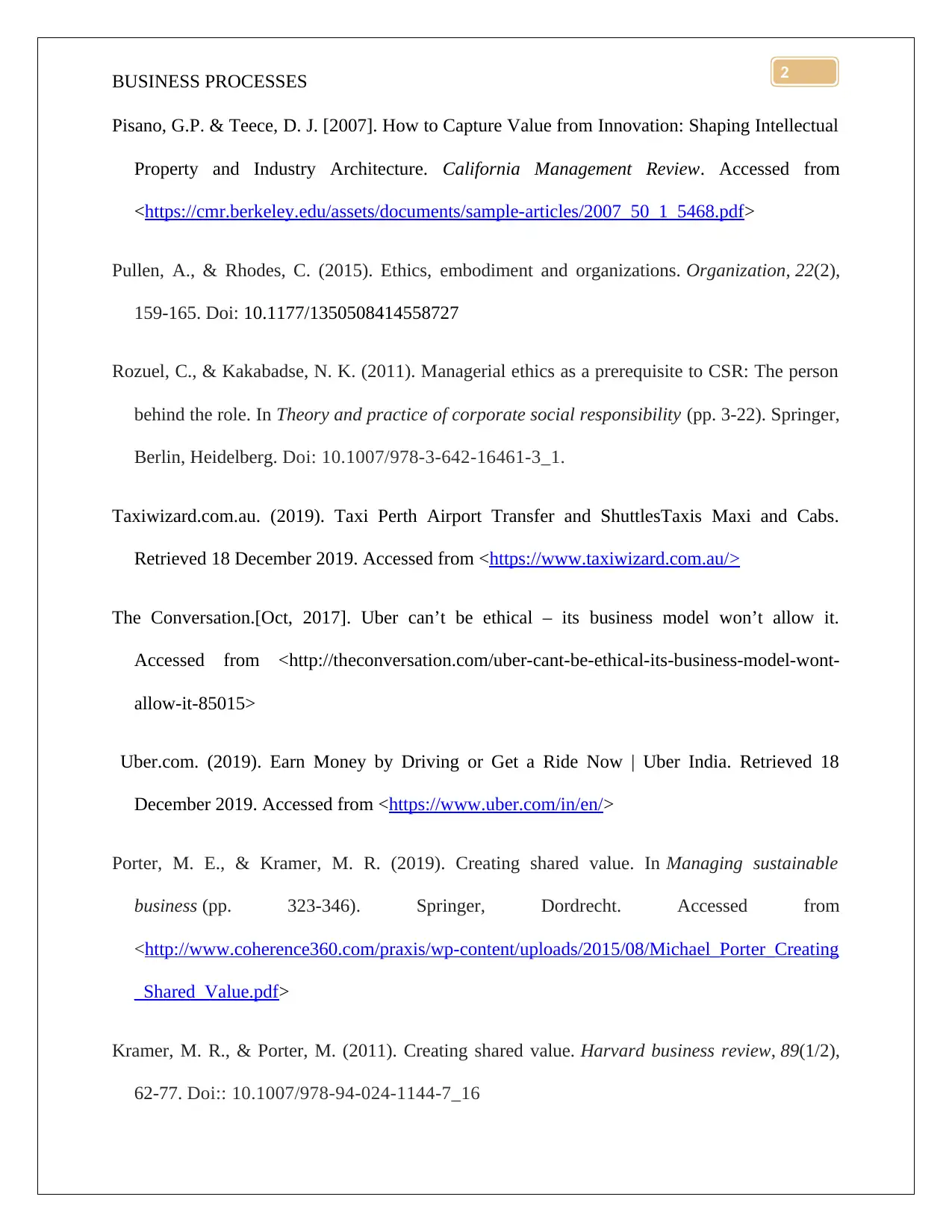
BUSINESS PROCESSES
Pisano, G.P. & Teece, D. J. [2007]. How to Capture Value from Innovation: Shaping Intellectual
Property and Industry Architecture. California Management Review. Accessed from
<https://cmr.berkeley.edu/assets/documents/sample-articles/2007_50_1_5468.pdf>
Pullen, A., & Rhodes, C. (2015). Ethics, embodiment and organizations. Organization, 22(2),
159-165. Doi: 10.1177/1350508414558727
Rozuel, C., & Kakabadse, N. K. (2011). Managerial ethics as a prerequisite to CSR: The person
behind the role. In Theory and practice of corporate social responsibility (pp. 3-22). Springer,
Berlin, Heidelberg. Doi: 10.1007/978-3-642-16461-3_1.
Taxiwizard.com.au. (2019). Taxi Perth Airport Transfer and ShuttlesTaxis Maxi and Cabs.
Retrieved 18 December 2019. Accessed from <https://www.taxiwizard.com.au/>
The Conversation.[Oct, 2017]. Uber can’t be ethical – its business model won’t allow it.
Accessed from <http://theconversation.com/uber-cant-be-ethical-its-business-model-wont-
allow-it-85015>
Uber.com. (2019). Earn Money by Driving or Get a Ride Now | Uber India. Retrieved 18
December 2019. Accessed from <https://www.uber.com/in/en/>
Porter, M. E., & Kramer, M. R. (2019). Creating shared value. In Managing sustainable
business (pp. 323-346). Springer, Dordrecht. Accessed from
<http://www.coherence360.com/praxis/wp-content/uploads/2015/08/Michael_Porter_Creating
_Shared_Value.pdf>
Kramer, M. R., & Porter, M. (2011). Creating shared value. Harvard business review, 89(1/2),
62-77. Doi:: 10.1007/978-94-024-1144-7_16
2
Pisano, G.P. & Teece, D. J. [2007]. How to Capture Value from Innovation: Shaping Intellectual
Property and Industry Architecture. California Management Review. Accessed from
<https://cmr.berkeley.edu/assets/documents/sample-articles/2007_50_1_5468.pdf>
Pullen, A., & Rhodes, C. (2015). Ethics, embodiment and organizations. Organization, 22(2),
159-165. Doi: 10.1177/1350508414558727
Rozuel, C., & Kakabadse, N. K. (2011). Managerial ethics as a prerequisite to CSR: The person
behind the role. In Theory and practice of corporate social responsibility (pp. 3-22). Springer,
Berlin, Heidelberg. Doi: 10.1007/978-3-642-16461-3_1.
Taxiwizard.com.au. (2019). Taxi Perth Airport Transfer and ShuttlesTaxis Maxi and Cabs.
Retrieved 18 December 2019. Accessed from <https://www.taxiwizard.com.au/>
The Conversation.[Oct, 2017]. Uber can’t be ethical – its business model won’t allow it.
Accessed from <http://theconversation.com/uber-cant-be-ethical-its-business-model-wont-
allow-it-85015>
Uber.com. (2019). Earn Money by Driving or Get a Ride Now | Uber India. Retrieved 18
December 2019. Accessed from <https://www.uber.com/in/en/>
Porter, M. E., & Kramer, M. R. (2019). Creating shared value. In Managing sustainable
business (pp. 323-346). Springer, Dordrecht. Accessed from
<http://www.coherence360.com/praxis/wp-content/uploads/2015/08/Michael_Porter_Creating
_Shared_Value.pdf>
Kramer, M. R., & Porter, M. (2011). Creating shared value. Harvard business review, 89(1/2),
62-77. Doi:: 10.1007/978-94-024-1144-7_16
2
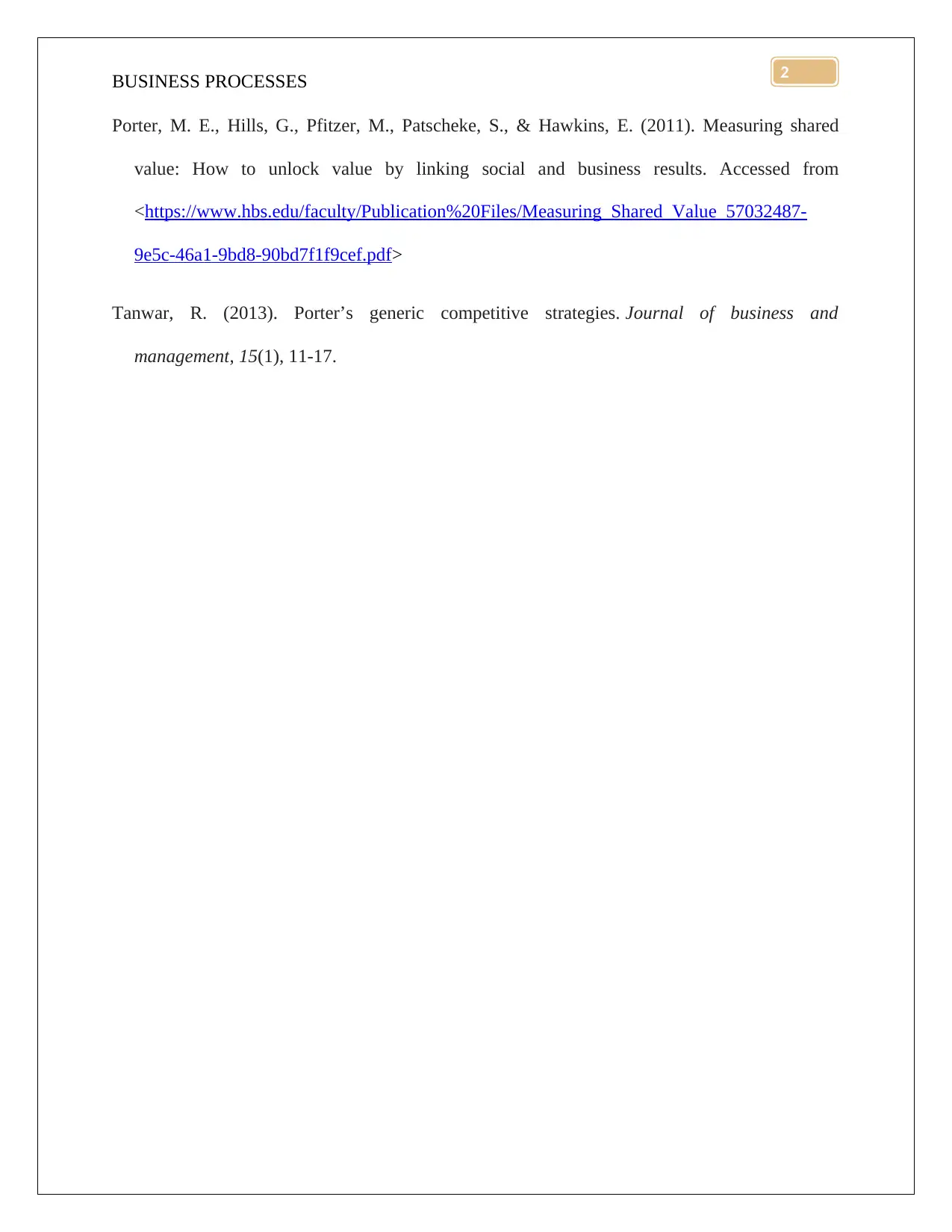
BUSINESS PROCESSES
Porter, M. E., Hills, G., Pfitzer, M., Patscheke, S., & Hawkins, E. (2011). Measuring shared
value: How to unlock value by linking social and business results. Accessed from
<https://www.hbs.edu/faculty/Publication%20Files/Measuring_Shared_Value_57032487-
9e5c-46a1-9bd8-90bd7f1f9cef.pdf>
Tanwar, R. (2013). Porter’s generic competitive strategies. Journal of business and
management, 15(1), 11-17.
2
Porter, M. E., Hills, G., Pfitzer, M., Patscheke, S., & Hawkins, E. (2011). Measuring shared
value: How to unlock value by linking social and business results. Accessed from
<https://www.hbs.edu/faculty/Publication%20Files/Measuring_Shared_Value_57032487-
9e5c-46a1-9bd8-90bd7f1f9cef.pdf>
Tanwar, R. (2013). Porter’s generic competitive strategies. Journal of business and
management, 15(1), 11-17.
2
1 out of 15
Related Documents
Your All-in-One AI-Powered Toolkit for Academic Success.
+13062052269
info@desklib.com
Available 24*7 on WhatsApp / Email
![[object Object]](/_next/static/media/star-bottom.7253800d.svg)
Unlock your academic potential
© 2024 | Zucol Services PVT LTD | All rights reserved.




